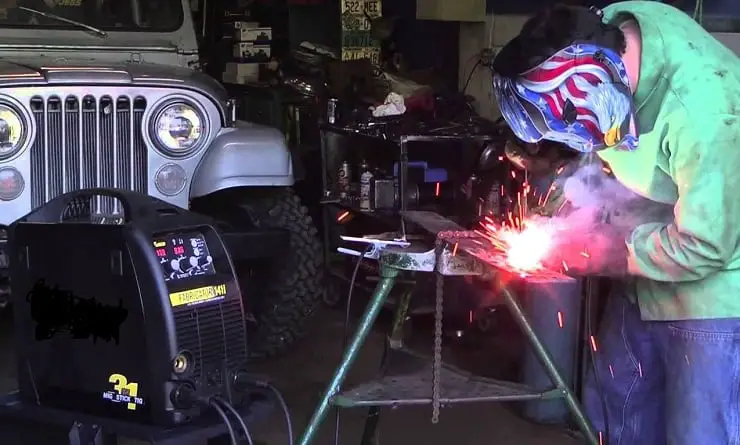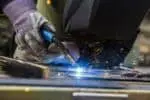 There are a variety of welders available in the market but not all of them are meant to be used at home. Using a home welding setup is quite a strategic task. You have to take safety, cost and the armamentarium into consideration. Which is why it is a frequently asked question that can you use a home outlet for welding?
There are a variety of welders available in the market but not all of them are meant to be used at home. Using a home welding setup is quite a strategic task. You have to take safety, cost and the armamentarium into consideration. Which is why it is a frequently asked question that can you use a home outlet for welding?
Simple answer is Yes! You can definitely run a welder at home but only after taking care of a few variables. Much like wiring in your house, contemplate the voltage and amperage required to operate the welder. If you are buying a welder to use domestically, double check your electrical box to make sure that you have a line providing 120 volt, 20 amps of service.
Don’t worry. Here’s a guide explaining what all you need for welding at home so that you don’t end up breaking or damaging something. Let’s get started!
How to decide which welder to run at home?
Most of the Outlet sockets in the USA run on 110V. Basically before using a welder look at the socket of it. If at the end of the plug you see a standard wall socket then you can definitely use it at home or on your regular outlets.
Most welders which are under 160 amps run fine on your regular household socket which is of 13 amps. However, you can also run large welders on a 13 amp socket with the help of an adaptor.
Although it isn’t recommended to run above 130 amps while welding. It is advisable to read the user’s manual and then use only those power supplies which are suitable for the machine.
How to handle the electrical setup for welding at home?
If you are going to purchase or run the welder, especially for the first time, make sure that you are well aware of the electric current your garage or home can supply to the welder.
With the lights on, you surely don’t want your breaker to be overloaded. There are low voltage welders available in the market which are designed to work in home outlets while for higher voltage models you need high capacity plugs.
If you are willing to use a MIG welder then you can use one such as Millermatic 141 since it doesn’t demand more than 120V and runs well in most outlets. But the story doesn’t end here.
While Millermatic 141 can handle all the welding projects at your home really well, there are some people who prefer to use a 220V welder at home for welding thicker metals on heavy duty projects or in order to produce sufficient heat for getting stronger welds. In case you are planning to use a 220V welder, install the plug that can handle the extra amperage.
Under certain circumstances if you are not able to modify your home setup or want some portability then you can make use of generators or welder and generator combination which can supply 3000, 4300 or 4500 watts of power. The only disadvantage with them is the amount of noise produced which I think can be tolerated.
See also: How Much Electricity Does a MIG Welder Use?
Shielding the weld pool at home
Once you have selected the welder, you might or might not want gas for shielding the weld pool. If we take stick welders into consideration then it creates a weld with flux coated electrodes which protects the weld pool so you really don’t need a shielding gas.
The disadvantage with flux core is that it is messy. No doubt it makes stick welding affordable and easier but at the same time it requires more skill than MIG welding.
Most of the welders choose MIG welder since it’s great for beginners plus it ends up giving you a clean weld. MIG welding which works with solid core wire demands shielding gas so that it can protect the weld. Depending on the type of material that you are welding, these gasses can be argon, carbon dioxide or sometimes the mixture of the two.
For shielding it is important to purchase a gas cylinder and at the same time it’s important that you make a wise decision. You might want to buy a 20-cf fuel cylinder but it’s advisable to go for large bottles which are quite cost effective. An 80 cf or 125 cf tank will save the cost of refilling along with saving your time.
Next comes the storage of the gas. While you set aside the gas, make certain that the position of your gas canisters are upright with almost negligible chances of falling over. It is highly recommended to assure that the canisters are placed safely away from the place of welding and sparks.
What all accessories are required for using a home outlet for welding?
Aren’t a welder, an electrode and shielding gas, the only required tools for welding at home? The answer is no! Besides these basic tools, you might require one of the following appliances:
-
-
- A metal cutting product like a chop saw or an acetylene torch.
- An angle grinder such as flap discs for preparing the metals before welding.
- Work clamps for keeping the materials at their correct position and for getting a neat weld.
- Auto darkening welding helmet
- Gloves
- Helmet
- And protective clothing as a part of your safety gear.
-
Besides these you can always be creative by building your own tool cart or you can simply adapt one. You just have to make sure that whatever you choose, you always stay safe and work conveniently.
Keeping the safety in mind
Whether you are working in a factory, a garage or at your home, you always have to keep safety in mind. A single spark can bring all of your workplace down. That is why there are few suggestions for keeping yourself and your area safe while welding at home.
-
-
- First and foremost, keep all the flammable materials such as rugs, fuels or gasses which are not in use away from the welder.
- You can create a welding shield with hooks in the ceiling with which you can hang the specially designed flame resistant blankets. Not only will it provide you safety but it will also prevent spatter from ruining your items.
- If you are welding at home make sure to keep at least two fire extinguishers in working condition.
- If possible carry out metal working in one place and wood working at another.
- Keep your working area clean and free from unnecessary littering. Don’t pile up unnecessary hoses and power cords.
-
Best Welders for home use MIG and stick
Half of your problems are solved when you have got the correct armamentarium. Here are best welders that you can use at your home
Hobart 500559 Handler 140 MIG Welder 115V
- 5-position voltage control selector adds a smooth, stable arc at all welding thicknesses
- Welding Processes: MIG(GMAW), Flux Cored(FCAW)
- Welding Amperage Range: 25-140 A; 20% duty cycle @ 90 Amps, 19V
- Whats Included: 10ft HR-100 MIG gun, 10ft work cable with clamp, Power Cord, Dual-gauge regulator with gas hose, .030 in. contact tips, Quick Select drive roll, Sample spool of flux-cored wire and Material thickness gauge
Prices pulled from the Amazon Product Advertising API on:
Product prices and availability are accurate as of the date/time indicated and are subject to change. Any price and availability information displayed on [relevant Amazon Site(s), as applicable] at the time of purchase will apply to the purchase of this product.
This is the strongest MIG welder which works at 140 amps which is suitable to be used at home. You can plug this one into a standard electrical socket and can use it for welding steel, stainless steel and aluminium. The machine comes with five different levels of voltage selection and also a wire feed speed range of 40-70 IPM.
Talking about the amperage, Hobart gives you great control over weld depth and you can set it from 25-140. You can weld upto ¼ “ mild steel with this at absolutely no load. Plus, it comes with a five year warranty. Amazing, right?
Pros:
✅ It is quite adjustable
✅ Comes with five years of warranty
✅ Welds upto ¼” of mild steel
✅ You can easily plug it into a standard electric outlet
Cons:
❌ It is very heavy and weighs almost 57 pounds
Check Price and Reviews on AmazonAHP AlphaTIG 200X 200 Amp IGBT AC DC Tig/Stick Welder
- Listing for 2021 203XI MODEL with Fully Controlled LCD Screen WILL BE SHIPPED . 200 HZ on PULSE and AC FREQ, NEW TORCH, 3 YEAR Warranty
- Advanced Inverter Technology with PWM (Pulse Width Modulation) Using IGBT technology
- quality TIG welding on aluminum, stainless or steel and precise welding of thinner-gauge materials
- unit features HF start tig and includes a foot pedal for great tig welding control and Operation
Prices pulled from the Amazon Product Advertising API on:
Product prices and availability are accurate as of the date/time indicated and are subject to change. Any price and availability information displayed on [relevant Amazon Site(s), as applicable] at the time of purchase will apply to the purchase of this product.
Alpha is one of the most versatile welders which combines both stick and TIG welding into one unit. It works on 110v and 220v electricity and is suitable to be fixed in any setup. It can weld upto ¼” aluminium and ⅜” steel.
Moreover, it comes with a fully controlled LCD screen, AC FREQ and a new torch with a three years of warranty. The model works on advanced inverter technology with pulse width modulation. You can also find a foot pedal for great welding control and operations.
Pros:
✅ Gives you the benefit of both TIG and stick type welding
✅ Can run on 110v and 220v electric
✅ Offers three year warranty
Cons:
❌ Difficult to carry because of its weight.
Check Price and Reviews on AmazonFinal Thoughts
So getting back to the question, can you use the welder at home? Yeah you can but only after considering a few factors. You have to make sure that your welder is single phase, you have got an apt power supply with a correct circuit breaker.
You have to also work with full safety otherwise you’ll end up hurting yourself. So go grab your welder today and start welding comfortably.









